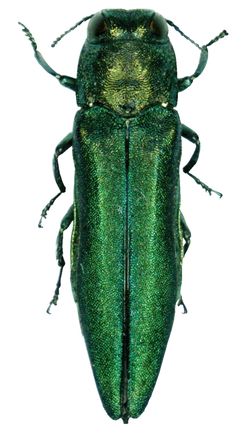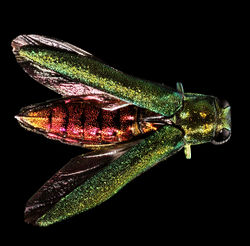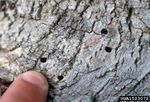Emerald ash borer
| Emerald ash borer |
|---|

|
| Scientific Classification |
| Scientific Name |
|
Agrilus planipennis |
Emerald ash borer is a species of beetle known by the scientific name Agrilus planipennis. They are an invasive species that came from Asia and can be easily recognize the it's green metallic color. It might have come to the states by wood cargo in planes and boats that are from Asia. They first appeared in Michigan, and has spread to other multiple states. It feeds on ash species so it has destroyed millions of ash trees that are in the States, scientist have tried many methods to control them but there's been no promising result.[2]
Body Design
The Emerald Ash Borer has a similar shape or color as a beetle, so people could be confused with them. [3] They are easy to spot because they have metallic green coloring. Their size is about 10mm to 13 mm length long. They have colors of Gold, Green, or Metallic.They can easily populate a huge area in a short time. Once a Ash tree grows, the Emerald Ash Borer attacks the bark or the leaves on the tree. When they attack the Ash tree, the tree could get infected because the Emerald Ash Borer is cutting off the access of the nutrients, and water the tree needs to have to live. They can relate to native species of the North American tree borers. So they have some similarities between them, like how they eat, feed, or mate. [4]
Life Cycle
The first stage of the emerald ash borer is the eggs. They are usually laid one at a time in mid June and August, the female emerald ash borer usually put the eggs in the outer bark and will hatch in about 2 weeks.The second stage which is larvae, after they hatch they chew on the bark and start feeding on the phloem, when feeding they leave S shaped galleries filled with waste, this is also one of the ways how to spot a tree infected with emerald ash borer by cutting the bark open and see if it's filled with S shaped etchings and they will stay there for one to two years. They will continue to feed over the winter so that they can pupate. While feeding they will eat feed on the cambial tissue of the tree which will eventually kill the tree [5].The third stage is Pupae, Larvae will spend their time overwinter in the bark to go through the pupation process to become adults. It will usually take two to three weeks for them to become adult beetles. The final stage is Adult, after the 2 weeks they have become adult beetles and will get out of the tree by chewing D-shaped holes, this is also another way to recognize emerald ash borer infested trees. After exiting the tree they will fly around to seek out new trees and females to begin the process again. The males and females will start feeding on leaves of the ash tree then proceed to mate and lay eggs before dying after two to three weeks.[6]
Ecology
The Emerald Ash Borer lives in eastern Asia's deciduous forests, also called temperate forests.[7] The temperature is mild, with summers averaging 70 degrees and winters averaging not too far below freezing. Rainfall is an average of 16 inches (averages of 14 in the winter and 18 in the summer).[8] This biome is home to many deciduous trees, including maple, oak, hickory, beech, and ash, which the Emerald Ash Borer eats.[9]
The larvae feed on the inner bark of the ash tree. After feeding, they leave a tunnel where the wood once was. The adult eats the leaves of the ash. This, on a small scale, does not kill the tree. In fact, it helps to keep the ash population in check. Otherwise, the ash trees could become too numerous.[10] The Emerald Ash Borer is food for woodpeckers and nuthatches. These birds feed on the larval stage of the Emerald Ash Borer.[11][12]
Invasive Species
Location and Method of Introduction The Emerald Ash Borer is located in Ohio, Arkansas, Indiana, Colorado, Georgia, Iowa, Kentucky, New Jersey, New York and many more. [13] They attack Ash trees and ruin their growth. They are native to Taiwan, Japan, China, Mongolia, Korea and Russia. Their first discovery in the North America was in 2002 at Michigan. The Emerald Ash Borer is dangerous to our Ash trees and we should definitely try to get rid of them. In the United States, the Emerald Ash Borer seem to only attack Ash trees. The Emerald Ash Borers also attack baseball bats and hockey sticks because they are made of Ash wood. [14]
Environmental Impact Emerald ash borers have killed million of ash trees throughout 10 years. The seedlings of ash tree will also be infected after it grows into a fully grown tree so if we didn't took care of the emerald ash borers in the past all of the ash trees would have begone by now but luckily we were able to control the emerald ash borers.[15]The loss of the ash tree could lead to the increase of invasive plants leading to the competition of food or reduce the forest health and productivity.It will also raise the population of the all the native trees cause all of the space there will be after all the ash trees die off [16]
Control Methods If you are the owner of an ash tree and do not want Emerald Ash Borers to kill the tree, many companies sell services of treating your tree with insecticides. The company workers will usually spray the bark, ground around the tree,or the leaves. If you are a scientist looking for a long term solution, the answer is to introduce a predator and/or parasite. Some parasitoids like Oobius agrili, Tetrastichus planipennsi, and Spathius agrili have been released into the US to help control the Emerald Ash Borer population.[17] Two of the most common predators of the Emerald Ash Borer are the woodpecker and the nuthatch. These two birds have been found to eat the Emerald Ash Borer larva.[12] Utilizing all these methods, scientists may finally be able to stop the Emerald Ash Borer from destroying all of the world's ash trees.
Video
A basic introduction to the Emerald Ash Borer.
References
- ↑ Agrilus planipennis "Wikispecies". Last Modified November 1 2015. Unknown Author.
- ↑ Robin, Usborne Emerald Ash Borer Emerald Ash Borer Information Network. Web. Accessed on November 10, 2016.
- ↑ Gary L. Parsons.2- Emerald Ash Borer Agrilus planipennis Fairmaire "Department of Entomology, Michigan State University". November 2008.
- ↑ Emerald Ash Borer - Agrilus planipennis) "Insect Identification". Published January 13, 2014. Unknown Author.
- ↑ Bauer, Lead. Biology and Life Cycle of Emerald Ash Borer Northern Research Station. Web. Last edited on March 14,2016.
- ↑ Emerald ash borer Wikipedia, the free encyclopedia. Web. Last edited on November 4, 2016. Unknown author.
- ↑ 23-31-Potential distribution of emerald ash borer: What can we learn from ecological niche models using Maxent and GARP? Science . Published Online July 15 2012. Unknown Author
- ↑ D.,PerryMoist Continental Climate Blue Planet . Accessed October 31 2016
- ↑ 1-Deciduous Forest: Plants Center for Educational . Last Updated April 28 2005. Unknown Author.
- ↑ Emerald Ash Borer Global invasive species database. Accessed October 31 2016. Unknown Author
- ↑ Biological Control of the Emerald Ash Borer USDA Forest Services. Last Edited May 6 2016. Unknown Author.
- ↑ 12.0 12.1 Galatzer-Levy,JeanneEmerald ash borer may have met its match UIC News Center. Published December 16 2013.
- ↑ - About Emerald Ash Borer"Emerald Ash Borer Information Network". October 9, 2013. Unknown Author.
- ↑ - Emerald Ash Borer "United States Department of Agriculture". Last Published October 27, 2016. Unknown Author.
- ↑ Emerald ash borer Wikipedia, the free encyclopedia. Web. Last edited on November 4, 2016. Unknown author.
- ↑ Bauer, Lead. Biology and Life Cycle of Emerald Ash Borer Northern Research Station. Web. Last edited on March 14,2016.
- ↑ Emerald Ash Borer Biological Control Forest Health Technology Enterprise. Accessed November 6 2016. Unknown Author.





